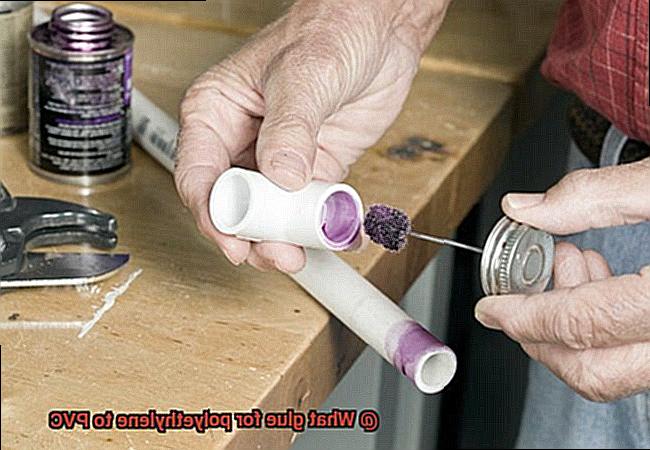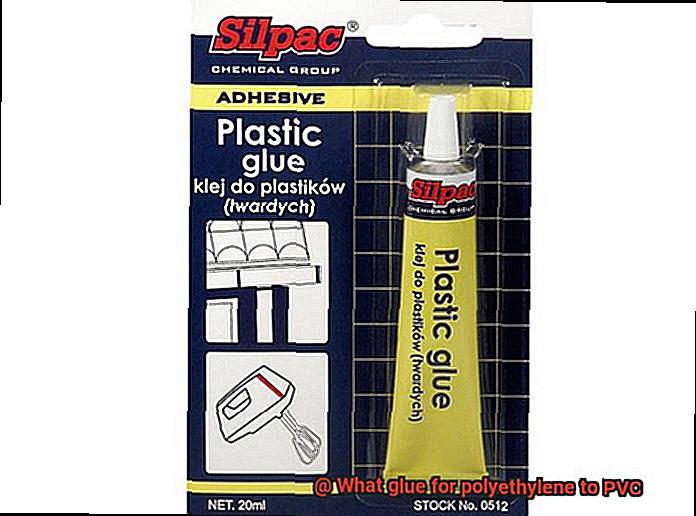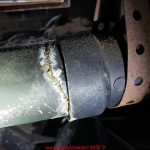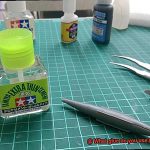Looking to glue polyethylene to PVC but not sure which adhesive to use? Don’t worry, we’ve got you covered. Polyethylene and PVC are two plastics with different chemical structures, making it seem like a challenge to bond them together. But fear not, there are solutions out there.
Polyethylene is a lightweight and flexible plastic that can be found in packaging materials, water tanks, and even toys. On the flip side, PVC (polyvinyl chloride) is a rigid plastic commonly used in plumbing pipes, electrical cables, and construction materials. So how do you join these two materials effectively?
In this blog post, we’ll dive into the process of bonding polyethylene to PVC and explore the best glue options for this specific application. Whether you’re a DIY enthusiast or a seasoned pro looking for guidance, we’ve got your back. Get ready to uncover the secrets of successfully bonding polyethylene to PVC.
Specialized Adhesives for Bonding Polyethylene to PVC
Contents
- 1 Specialized Adhesives for Bonding Polyethylene to PVC
- 2 The Importance of Surface Preparation
- 3 Using a Polyethylene Adhesive
- 4 Using a Two-Part Epoxy Adhesive
- 4.1 Step 1: Prepare for Battle – Cleaning the Surfaces
- 4.2 Step 2: Assemble Your Arsenal – Mixing the Epoxy Adhesive
- 4.3 Step 3: Apply the Magic Potion – Even Layer Application
- 4.4 Step 4: Unite the Forces – Squeeze Them Together
- 4.5 Step 5: Grant Time for Curing – Be Patient, Hero
- 4.6 Step 6: Marvel at Your Creation – A Bond That Withstands All
- 5 Selecting the Right Epoxy Adhesive
- 6 Enhancing the Bond Strength with Primers
- 7 Limitations of Bond Strength and Durability
- 8 Alternative Fastening Methods for Joining Polyethylene and PVC
- 9 Conclusion
Bonding polyethylene to PVC can be a challenging task due to their different chemical compositions and surface energy levels. However, with the right adhesive and proper preparation, you can achieve a strong and durable bond between these materials. In this comprehensive guide, we will explore the types of specialized adhesives commonly used for bonding polyethylene to PVC. We will also provide key considerations and expert tips to ensure a successful bond.
Types of Specialized Adhesives:
- Solvent-based adhesives: Solvent-based adhesives are popular for bonding polyethylene to PVC as they partially dissolve the surfaces of both materials, allowing them to fuse together when the solvent evaporates. These adhesives create strong bonds, but proper surface preparation and adequate curing time are crucial for optimal results.
- Polyethylene adhesives: Specifically designed for bonding low surface energy plastics like polyethylene and PVC, these liquid adhesives offer excellent adhesion properties. They require thorough surface cleaning and often need drying time before joining the surfaces.
- Epoxy adhesives: Known for their high strength and durability, epoxy adhesives can also be used for bonding polyethylene to PVC. However, it is crucial to select an epoxy adhesive specifically formulated for plastic bonding, as not all epoxy adhesives are suitable for this application.
Considerations for a Successful Bond:
- Surface preparation: Start by thoroughly cleaning both polyethylene and PVC surfaces, removing any dirt, grease, or contaminants. Roughen the surfaces with sandpaper or an abrasive pad to enhance adhesion by creating more points of contact.
- Adhesive application: Follow the manufacturer’s instructions carefully when applying the adhesive. Apply it evenly and thinly onto both surfaces using a brush or applicator. Remove excess adhesive before it dries to ensure a neat and strong bond.
- Pressure and curing time: Press the surfaces firmly together to ensure good contact and maximum adhesion. Use clamps or weights to hold them in place during the curing process. Allow sufficient curing time, as recommended by the adhesive manufacturer, for the bond to reach its full strength.
- Bond strength testing: Before subjecting the bond to heavy loads or stress, it is advisable to test its strength. This can be done by applying gradual pressure or performing a peel test to assess the durability of the bond for your specific application.
- Environmental considerations: Take into account factors such as temperature, moisture, and stress that may affect the longevity of the bond. For structural applications or high-stress environments, mechanical fastening methods like screws or rivets may provide a more reliable connection.

The Importance of Surface Preparation
Well, buckle up because we’re about to spill the beans and show you how to achieve a bond that will make even the strongest superheroes jealous.
Let’s start with the basics. Polyethylene and PVC are notorious for their low surface energies, which basically means they have a natural aversion to bonding with other materials, including adhesives. It’s like trying to stick two magnets with the same poles together – not an easy feat. But fear not, because surface preparation is here to save the day.
First things first, we need to get rid of any contaminants that might hinder our bond. Think oils, grease, dirt, dust – all the things that make surfaces slippery and uncooperative. We want our adhesive to have a clean canvas to work its magic, so grab your cleaning supplies and give those surfaces a good scrub.
We don’t just want clean surfaces; we also want them to be rough and ready for action. By creating a textured surface through sanding, scoring, or roughening, we’re giving our adhesive more points of contact to grip onto. It’s like Velcro for materials – the more hooks and loops, the stronger the bond.
Now, here’s a pro tip: different adhesives may require specific surface preparations. Some might need a little priming or solvent cleaning before application, while others may have their own preferences for sanding or roughening. Don’t worry, though – just follow the manufacturer’s instructions, and you’ll be on your way to bonding bliss.
So there you have it – the importance of surface preparation when bonding polyethylene to PVC. It’s like getting your materials ready for a dance – clean, rough, and oh-so-ready to tango with the adhesive. By taking the time to prepare those surfaces, you’ll unlock the true potential of your bond, ensuring a connection that can withstand anything life throws at it.
But why stop there? Let’s dive deeper into the nitty-gritty of surface preparation and explore its various aspects:
- Overcoming Low Surface Energies: Polyethylene and PVC have low surface energies, which means they naturally repel adhesives. Surface preparation helps break through this resistance by creating a roughened surface that allows the glue to penetrate and form a strong bond.
- Banishing Contaminants: Oils, grease, dirt, dust, and moisture are the enemies of adhesion. They create a barrier between the adhesive and the surfaces, hindering proper bonding. Thorough cleaning is essential to remove these impurities and ensure a clean surface for adhesive application.
Using a Polyethylene Adhesive
Polyethylene adhesive is a powerful tool for joining polyethylene to PVC, but it’s important to understand the process to achieve the best results. So, let’s dive into the nitty-gritty of using this adhesive and create bonds that would make the Hulk jealous.
Polyethylene is a sturdy plastic commonly found in various products, from pipes to packaging materials. However, its low surface energy poses a challenge for adhesives. Luckily, polyethylene adhesive is specifically designed to tackle this issue head-on.
Before you begin the bonding process, take the time to thoroughly clean the surfaces. No one wants a bond with dirt and grease. Grab some mild detergent or an alcohol solution and wipe away any lurking impurities. A clean surface is paramount for a strong bond.
Now comes the exciting part – applying the adhesive. Polyethylene adhesives are typically in liquid form. Use a brush or a syringe to spread this magical potion onto both the polyethylene and PVC surfaces. Remember, even application is crucial for success.
But hold on, we’re not finished just yet. Once you’ve applied the adhesive, it’s time to bring those surfaces together. Give them a good squeeze to ensure maximum contact between the two materials. Clamps or other mechanical aids can help hold everything in place while the adhesive works its magic.
Now, here’s where patience becomes key. The curing time for polyethylene adhesives can vary depending on factors like temperature and humidity. So, take a moment to relax and let the adhesive do its thing. Avoid subjecting your newly bonded materials to stress or load until they’re fully cured.
Before we wrap things up, let’s address an important point: not all polyethylene adhesives are created equal. Choosing an adhesive specifically designed for your type of polyethylene and PVC is crucial. Don’t hesitate to reach out to the adhesive manufacturer or seek professional advice to ensure you’re using the right product.
Using a Two-Part Epoxy Adhesive
Look no further. In this comprehensive guide, we will delve into the captivating world of two-part epoxy adhesive. This magical potion has the power to conquer the low surface energy of polyethylene, transforming it into an unstoppable force when combined with PVC. So, fasten your cape and prepare for an epic adventure in bonding polyethylene to PVC.
Step 1: Prepare for Battle – Cleaning the Surfaces
Before embarking on this heroic journey, it is crucial to ensure that both surfaces are squeaky clean. Rid them of any dirt, grease, or contaminants that could hinder your quest for a strong bond. Think of a clean surface as a blank canvas, ready to be transformed into a masterpiece.
Step 2: Assemble Your Arsenal – Mixing the Epoxy Adhesive
With your surfaces primed and ready, it’s time to unleash the power of your two-part epoxy adhesive. Gather the resin and hardener components and meticulously follow the manufacturer’s instructions to mix them together. Pay close attention to the proportions and mixing time – they hold the key to unlocking the adhesive’s full potential.
Step 3: Apply the Magic Potion – Even Layer Application
Now that your adhesive concoction is ready, apply an even layer onto both surfaces. Utilize a brush or spatula as your trusty sidekick in spreading this magical potion evenly. Remember, a balanced application ensures an equal distribution of strength across the bond.
Step 4: Unite the Forces – Squeeze Them Together
The moment of truth has arrived – press your polyethylene and PVC together firmly. Employ clamps or any means necessary to apply pressure and create an unbreakable bond. The strength of the squeeze directly correlates to the mightiness of the bond.
Step 5: Grant Time for Curing – Be Patient, Hero
Just like a superhero needs time to recover after a battle, your adhesive also requires time to cure. The exact curing time varies between products, so consult the manufacturer’s instructions and grant it the necessary time to become fully invincible.
Step 6: Marvel at Your Creation – A Bond That Withstands All
After your epoxy adhesive has fully cured, take a moment to bask in the glory of your creation. The bond you’ve forged is resistant to moisture, chemicals, and temperature fluctuations – a true force to be reckoned with.
Selecting the Right Epoxy Adhesive
Selecting the perfect epoxy adhesive to bond polyethylene to PVC requires careful consideration of various factors. Let’s dive into the world of epoxy adhesives and explore how to choose the right one for this specific application.
- Compatibility is key: Not all epoxy adhesives are created equal, so it’s crucial to find one that is specifically formulated for bonding polyethylene and PVC. Look for adhesives that explicitly mention compatibility with these materials.
- Strength matters: Polyethylene and PVC can be stubborn when it comes to bonding, so you need an epoxy adhesive that packs a punch in the adhesion department. Seek out an adhesive that offers excellent adhesion strength to ensure a bond that can withstand the test of time.
- Time is of the essence: Some epoxy adhesives take forever to cure, which might not work if you need a quick bond. Luckily, there are options available with rapid cure times, allowing you to get the job done in a flash.
- Consider the environment: Will your bonded materials be exposed to extreme temperatures, harsh chemicals, or UV radiation? These factors can wreak havoc on certain adhesives, so choose one that can handle whatever Mother Nature throws at it.
- Seek guidance: Don’t be afraid to tap into the expertise of adhesive manufacturers and industry professionals. They have a wealth of knowledge when it comes to bonding polyethylene to PVC and can help guide you towards the right epoxy adhesive for your specific needs.
Enhancing the Bond Strength with Primers
When it comes to bonding polyethylene and PVC, primers are the secret ingredient that can take your projects to the next level. These magical substances are specifically designed to enhance the bond strength between these two materials, ensuring that your creations stay intact for years to come.
Not all primers are created equal, and using the right primer for polyethylene and PVC is crucial for achieving optimal bond strength. Generic primers simply won’t cut it. You need a primer tailored to the unique properties of these plastics, or you risk ending up with a weak bond or even failure.
So, what sets these primers apart? One type commonly used in this application is a solvent-based primer. These powerhouses contain solvents that work their magic by softening and preparing the surface of the polyethylene and PVC. By dissolving a thin layer of plastic, they create a rougher surface that provides a better grip for the adhesive, resulting in a stronger bond. It’s like giving your glue a firm handshake.
But that’s not all – there’s another type of primer that can work wonders: adhesive promoters. These matchmakers for your adhesive and plastics create a chemical reaction that enhances the adhesive’s ability to bond with polyethylene and PVC. They bring your glue and plastics together, saying “Hey, you guys are going to get along great.”
However, before you rush off to grab a primer, it’s important to remember one thing: always follow the manufacturer’s instructions. Applying the primer in the correct order, allowing sufficient drying time, and working in a well-ventilated area are crucial steps for success. Don’t let your bond go sour just because you didn’t read the fine print.
And let’s not forget about the adhesive itself. Choosing an adhesive specifically designed for bonding polyethylene and PVC is just as important as using the right primer. These adhesives are formulated to provide excellent bond strength, ensuring that your projects stay together even when faced with tough challenges.
Limitations of Bond Strength and Durability
Bonding polyethylene and PVC can be a formidable task, as achieving a strong and durable bond between these materials poses several challenges. In this blog post, we will delve into the limitations of bond strength and durability, shedding light on the complexities of using glue as a bonding agent.
Differences in Chemical Composition and Physical Properties:
Polyethylene and PVC have distinct chemical compositions and physical properties that present hurdles for adhesion. Polyethylene’s low surface energy makes it resistant to adhesive bonding, while PVC’s smooth and non-porous surface hampers effective adhesion.

Incompatibility with Conventional Adhesives:
Conventional adhesives struggle to bond effectively with polyethylene or PVC due to their high degree of crystallinity and chemical inertness. The crystalline structure of polyethylene limits adhesive penetration, while the chemically inert nature of both materials impedes effective interaction with adhesives.
Durability Concerns:
The durability of the bond between polyethylene and PVC is another limitation to consider. Differences in thermal expansion coefficients and flexibility can create stress concentrations at the interface, leading to eventual weakening or failure of the bond. Additionally, environmental factors such as temperature changes and moisture can further degrade the bond over time.
Specialized Adhesives:
There are specialized adhesives available for bonding polyethylene to PVC, but they too have limitations. These adhesives are formulated with chemical additives that enhance compatibility between the adhesive and the materials being bonded. However, it is crucial to carefully evaluate their limitations before selecting the appropriate adhesive for your specific application.
Alternative Fastening Methods for Joining Polyethylene and PVC
Joining polyethylene and PVC materials can be a daunting task due to their distinct properties that render conventional glue options ineffective. However, fear not. In this blog post, we will explore alternative fastening methods that can effectively join these materials together. Let’s dive in.
Mechanical Fasteners:
One alternative method is using mechanical fasteners like screws or bolts. These offer a robust and enduring joint, provided you opt for corrosion-resistant options suitable for the environmental conditions they will encounter.
Heat Welding:
Heat welding involves melting the polyethylene and PVC materials together using specialized equipment such as a hot air gun or heat fusion machine. This method creates a permanent bond, making it ideal for applications requiring a strong and leak-proof joint. Picture the two materials fusing together under intense heat, creating an unbreakable connection.
Solvent Welding:
Solvent welding harnesses solvent-based adhesives that dissolve the surface of the materials, allowing them to fuse together upon drying. It is commonly employed in PVC pipe fabrication due to its ability to provide a reliable and robust joint. Imagine the solvents delicately melding the materials into a seamless bond.
Compression Fittings:
Compression fittings consist of a nut, sleeve, and insert that are tightened onto the pipes, ensuring a secure connection. This method is quick and easy to install, making it popular in plumbing applications. Visualize the components coming together like puzzle pieces, interlocking tightly to form a solid joint.
Adhesive Bonding:
Adhesive bonding can also be used to join polyethylene and PVC materials. However, it is crucial to select an adhesive specifically designed for bonding these plastics. Consulting adhesive manufacturers or experts is highly recommended to ensure compatibility. Envision the adhesive acting as a bridge between the two materials, creating an unbreakable link.
K9fXYmMffqs” >
Conclusion
When it comes to bonding polyethylene to PVC, finding the right glue is crucial.
Fortunately, there are a few options available that can effectively join these two materials together. One popular choice is a specialized adhesive called “polyurethane glue.”
This type of glue is known for its strong bond and versatility, making it ideal for connecting polyethylene and PVC surfaces. Another option is using a solvent-based adhesive specifically designed for bonding plastics.
These adhesives work by softening the plastic surfaces and creating a chemical bond between them. However, it’s important to note that not all glues will work for this particular combination of materials.
It’s essential to choose a glue that is specifically formulated for bonding polyethylene and PVC to ensure a successful and long-lasting bond.






